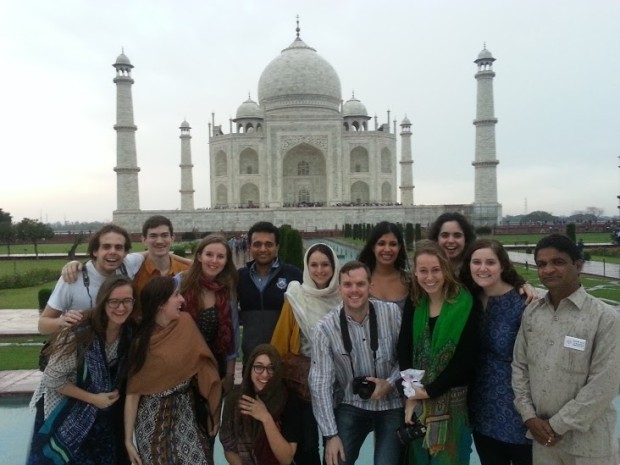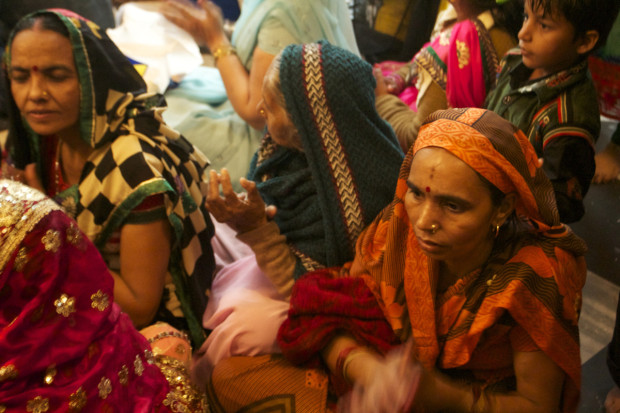VRINDAVAN—At the beginning of the trip, Professor Trivedi told us that planning ahead is helpful but not always absolute in India. Between monkey attacks, a carnival and unforgiving weather, our fourth day traveling around Vrindavan, Lord Krishna’s place of birth, and Agra, home to the Taj Mahal, proved his point a little too well. Each of the major stops along the way had instances of unpredictability that could have been plucked straight out of a movie.
Because of Lord Krishna’s connection to Vrindavan, there are multiple mandirs dedicated to him. Amidst cries of “Radhe! Radhe!” the enthusiastic chant to praise Krishna, we strolled through a few, spending most of our time in the Govinda Dev mandir. This temple was definitely the most “established” out of the ones we initially visited. As a rather large construction with construction dating back to the Mughal period, Govinda Dev is reminiscent of the India from storybooks.
“Beware of the monkeys” proved to be one of the warnings that remained essential throughout the day. They were everywhere in Vrindavan and the Govinda Dev mandir had young kids use large sticks to chase them away. Unfortunately, we fell victim to their viciousness. A fat little primate with a red behind crept towards a walking Rutwij and snatched his glasses from his hand. It was remarkable how confident the monkey was! We recovered the glasses, though only in parts.
We continued our introduction to Krishna bhakti through a visit to an ISKCON (International Society for Krishna Consciousness) temple. Here, devotion is not only seen through traditional chanting and singing, but through dance. The energy is vibrant, and women and men are grouped together. Yet the most noticeable aspect was the number of foreigners there. Even amongst the singing monks, there were faces that were clearly not Indian. We later learned that there is a large Russian community in Vrindavan that is devoted to the ISKCON faith. Oftentimes I think karma and yoga are the only two aspects of Hinduism that have gained momentum beyond India, but Lord Krishna is a deity that represents the branches of Hinduism that have resonated abroad.
We rounded out our visit to Vrindavan by meeting Acharya Srivatsa Goswami at his ashram in Jai Singh Ghera. Unlike previous personalities we have had the chance to meet, he spoke to us in a very direct and honest way. He cited Greek mythology and French literature in addition to referencing the Vedas. It was clear he was not speaking to us as a spokesperson for his tradition, but as an educator. Some of the main themes he touched upon were the differences of religions of the book versus religions of the spoken word, the influence of media in Indian politics and Hinduism’s role in celebrating variety. What struck me the most were his thoughts on the relationship between nationalism and Hinduism. Others who have spoken to us seemed to have given us a glossy PR spin, but the Maharajji, as he is affectionately known, stayed away from this and challenged our questions with some of his own: “What India are you talking about?” “What does nationalism really mean?” “Is there really one unified version of Hinduism?” “Who speaks for all the Hindus?” He reminded us that it certainly was not the two prominent right-wing Hindu organizations, the RSS or the VHP. His questions and explanations were representative of the pluralism found in India.
Getting back to the bus on the Vrindavan roads was extremely difficult because of rain that had come pouring down while we were in conversation with the Maharajji. To make matters more complicated, the village was having a carnival on its main road. It seemed almost inevitable that we would separate, but I never expected it to be as overwhelming. Walking through a carnival full of people, trying to catch up to the others while wading through flooded roads teeming with rickshaws, motorcycles, and even an elephant on the road is an experience I will not forget. As our group reunited, I was thankful not only that we were all safe, and that we had been evenly split, but that everyone in our group seemed to be aware that India is unpredictable — an unpredictability some can learn to enjoy. I kept thinking that accepting the chaos is linked to India’s trust in a higher power. Perhaps a strong hold on faith is the reason why this country seems to be especially okay with the constant pandemonium.

India Yatra reporters with Professor Trivedi and host at the Taj Mahal near Agra, India. Photo by Sam Steinberger.
Upon our late arrival to the Taj Mahal, we thought we had dodged all the day’s curve balls. Alas, this was not the case. We arrived well after the closing of the gates for the viewing of this world wonder. Thanks to Ashwini Sharma, who had been appointed as our facilitator by the District Magistrate’s office, we were able to speed through the security and avoid the long lines typically associated with the edifice. After taking about a hundred photos of the mausoleum, which I was incredibly grateful to see, a thunderstorm came to greet us. The Taj was stunning against the sunset under the pouring rain though the same couldn’t be said for my disheveled fellow Columbia journalists and I. We took a quick tour of the place, which was quite unique since we had the chance to do so at night. Nightfall also gave the site’s tombs more prominence. It seemed less touristy in the dark. After a day devoted to Krishna bhakti, I had to keep reminding myself that I was now in the vicinity of two mosques and a building that is recognized as the pinnacle of Islamicate architecture.
It was an emotionally and physically exhausting day. We were all out of our comfort zones, trying to grapple with the transition from urban bustle to rural religiosity. The human kindness we were treated to throughout the day made our lives a little bit easier. Volunteers serving us a traditional lunch at the ashram and being given a pair of new sandals after mine broke at the Taj Mahal served as examples of how within the disarray in India, there is much humanity. Much like Hinduism, India is a way of life. Being here is an experience where all senses are involuntarily heightened. The panorama can change in just a few hours, which as journalists, gives us so much to write about and so much to learn.

We are thoroughly enjoying your daily dispatches and are grateful that our granddaughter has the opportunity to be part of this group of dedicated young journalists.
We sincerely hope you all continue to be awed and educated by your experience in investigative reporting. We can think of nothing our world needs more than people who are willing to find the “real” story and brave enough to write and publish it.
Bob and Carol Bement
Hi Bob and Carol,
How wonderful to know that our children and grandchildren will be leaving an amazing legacy for all to read, hear and see.
I’m loving the photographs and starting to appreciate just how talented everyone is.
So looking forward to the next report and wonderful pictures.
Virginia and Alan